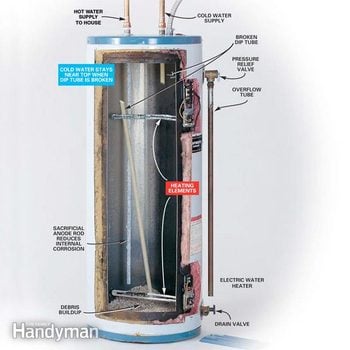How to Repair or Replace Defective Water Heater Dip Tubes
Updated: Feb. 21, 2023Check your water heater in case you have a defective dip tube.

- Time
- Complexity
- Cost
- A full day
- Advanced
- $101–250
Check for defective dip tubes
If you have hot water problems (loss of water temperature and/or loss of water pressure at water delivery points) and your water heater was made between 1993 and 1997, you have a lot of company. During that time, nearly all the major water heater manufacturers were buying the same defective plastic dip tubes from the same manufacturer and installing them in their gas and electric units. Unfortunately, depending on your water chemistry, its pH and the temperature setting of the water heater, these tubes eventually break, crumble and/or dissolve into various size pieces.
The pieces clog strainers and filter screens on appliances and faucets, and the partial or complete absence of the dip tube severely harms water heater performance.
The role of the dip tube is to direct incoming cold replacement water to the bottom of the tank for heating. While it warms, the dense, cold water stays naturally segregated from the warmer, lighter water floating on top. The water for faucets and appliances comes from the hot layer on top. If the dip tube is missing, the cold incoming water mixes with the hot water at the top of the tank and you wind up feeding the house with tepid instead of hot water.
If you’re having hot water problems, first see if you have a water heater made during those bad dip tube years. Often, the first four numbers on the serial number are the month and year of manufacture. If the third and fourth numbers are 93, 94, 95, 96 or 97, it could be affected. If you have a bad unit, there are two options. First, replace the water heater and flush all the faucet screens and filters throughout the house. (If your water heater is more than 10 years old, it’s nearing the end of its life, so it’s probably worth replacing.) New water heaters have dip tubes that’ll last as long as the water heater.
Or second, replace the defective dip tube with a cross-linked polyethylene one and flush the debris out of the water heater and the screens and filters. You may have to flush the system more than once.
Figure A: Water Heater Cutaway Showing Broken Dip Tube
The cutaway shows the details of an electric water heater and a broken dip tube. Note: Figure A can be downloaded and printed from Additional Information below.
